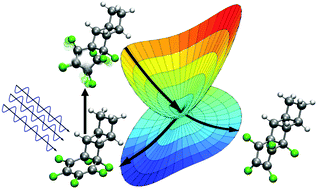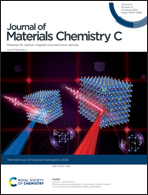Multiconfigurational dynamics explain photochemical reactivity and torquoselectivity towards fluorinated polyacetylenes†
Abstract
The discovery of the conductivity of polyacetylene ignited the field of organic electronic materials. Functionalizing polyacetylenes with electron withdrawing groups (e.g., fluorine), has been predicted to increase the air-stability of PAs and open new avenues in organic electronics. Burns and coworkers recently reported a novel synthetic route to fluorinated polyacetylenes which utilizes as a key step towards the stereoselective photochemical electrocyclic ring-closing of hexafluorinated dienes. We call this selectivity, photo-torquoselectivity. While Houk's torquoselectivity model predicts the stereoselectivity of thermal electrocyclic reactions, no such reactivity model exists for their photochemical counterpart. We have used multiconfigurational quantum chemical calculations and ab initio molecular dynamics simulations to describe this reaction and to determine the origin of its stereoselectivity. We show that the reaction proceeds through the S1 excited state with a half-life of 445 fs. This reaction lies along an energetically unfavorable pathway which results in a reaction quantum yield of approximately 14%. We predict that the reaction pathway to the unobserved product lies as much as 0.3 eV (6.9 kcal mol−1) higher in energy than the pathway to the observed isomer. The reaction pathway to the observed product benefits from stabilizing Fδ−⋯Hδ+ interactions while the pathway to the unobserved product suffers from destabilizing F–F closed-shell repulsion. The combination of these two stereoelectronic effects is responsible for the difference in energy between the two pathways which directs the reaction exclusively to the observed product.

- This article is part of the themed collection: Journal of Materials Chemistry C Emerging Investigators


 Please wait while we load your content...
Please wait while we load your content...
